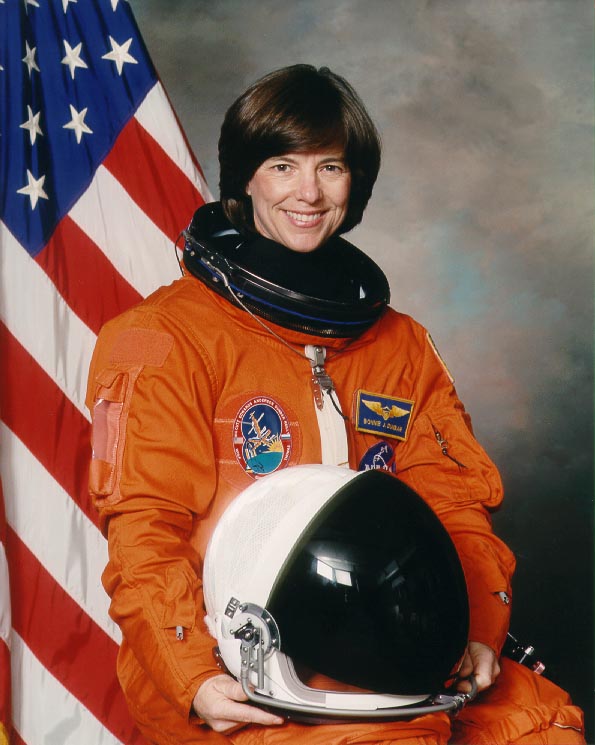Bonnie J. Dunbar
American - (NASA)
Retired
Date of Birth: March 3, 1949
Age: 76
Bonnie Jeanne Dunbar is a former NASA astronaut. She retired from NASA in September 2005 then served as president and CEO of The Museum of Flight until April 2010. From January 2013 - December 2015, Dr. Dunbar lead the University of Houston's STEM Center (science, technology, engineering and math) and was a faculty member in the Cullen College of Engineering.[1] Currently, she is a professor of aerospace engineering at Texas A&M University and serves as Director of the Institute for Engineering Education and Innovation (IEEI), a joint entity in the Texas A&M Engineering Experiment Station (TEES) and the Dwight Look College of Engineering at Texas A&M University.
Space Shuttle Challenger / OV-099 | STS-61-A
National Aeronautics and Space Administration | United States of AmericaKennedy Space Center, FL, USA
Oct. 30, 1985, 5 p.m.
Status: Success
Mission:
STS-61-A was the twenty-second space shuttle flight and ninth for Space Shuttle Challenger. It was a scientific spacelab mission funded entirely by West Germany. The payload operations were controlled from the German Space Operations Center as opposed to the regular NASA centers.
Low Earth OrbitSpace Shuttle Columbia / OV-102 | STS-32
National Aeronautics and Space Administration | United States of AmericaKennedy Space Center, FL, USA
Jan. 9, 1990, 12:35 p.m.
Status: Success
Mission:
STS-32 was the thirty-third mission of the shuttle program and ninth of Columbia. It was the first use of Launch Pad 39A and also marked the first use of the Mobile Launcher Platform No. 3 (MLP-3) in the shuttle program. This was the longest flight of the shuttle program lasting nearly 11 days. Its primary missions were to deploy a defence 10 satellite and retrieved NASAs Long Duration Exposure Facility.
Low Earth OrbitSpace Shuttle Columbia / OV-102 | STS-50
National Aeronautics and Space Administration | United States of AmericaKennedy Space Center, FL, USA
June 25, 1992, 4:12 p.m.
Space Shuttle Atlantis / OV-104 | STS-71
National Aeronautics and Space Administration | United States of AmericaKennedy Space Center, FL, USA
June 27, 1995, 7:32 p.m.
Status: Success
Mission:
STS-71 was the third mission of the US/Russian Shuttle-Mir Program and the first Space Shuttle docking to Russian space station Mir. It started on 27 June 1995 with the launch of Space Shuttle Atlantis from launch pad 39A at the Kennedy Space Center in Florida. The shuttle delivered a relief crew of two cosmonauts Anatoly Solovyev and Nikolai Budarin to the station and recovered Increment astronaut Norman Thagard. Atlantis returned to Earth on 7 July with a crew of eight. It was the first of seven straight missions to Mir flown by Atlantis.
Low Earth OrbitSpace Shuttle Endeavour / OV-105 | STS-89
National Aeronautics and Space Administration | United States of AmericaKennedy Space Center, FL, USA
Jan. 23, 1998, 2:48 a.m.
The National Aeronautics and Space Administration is an independent agency of the executive branch of the United States federal government responsible for the civilian space program, as well as aeronautics and aerospace research. NASA have many launch facilities but most are inactive. The most commonly used pad will be LC-39B at Kennedy Space Center in Florida.
Long March 3B/E
Fengyun-4C
Launch Complex 2 (LC-2) - Xichang Satellite Launch Center, People's Republic of ChinaChina's geostationary meteorological satellite program FY-4 (Feng Yun 4) is the second generation of chinese geostationary meteorological satellites.
Long March 8A
SatNet LEO Group 17
Commercial LC-1 - Wenchang Space Launch Site, People's Republic of ChinaA batch of 9 Low Earth Orbit communication satellites for the Chinese state owned SatNet constellation operated by the China Satellite Network Group.…
Soyuz 2.1a
Obzor-R No.1
43/4 (43R) - Plesetsk Cosmodrome, Russian FederationNote: Assignment of payloads to this launch is uncertain. The Russian Obzor-R satellite is a planned X-band radar earth observation satellite desi…
LVM-3 (GSLV Mk III)
BlueBird Block 2 #1
Satish Dhawan Space Centre Second Launch Pad - Satish Dhawan Space Centre, IndiaAST SpaceMobile’s Block 2 BlueBird satellites are designed to deliver up to 10 times the bandwidth capacity of the BlueBird Block 1 satellites, requi…
Long March 12A
Demo Flight
Long March 12A Pad - Jiuquan Satellite Launch Center, People's Republic of ChinaFirst test launch of CASC/SAST’s Long March 12A rocket, with a dummy payload. The rocket’s 1st stage attempted to land on a landing pad about 300 km …



